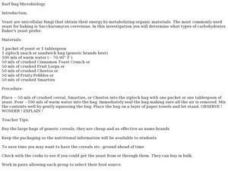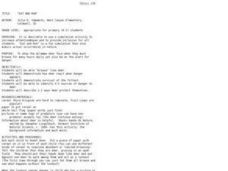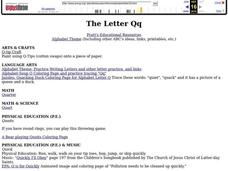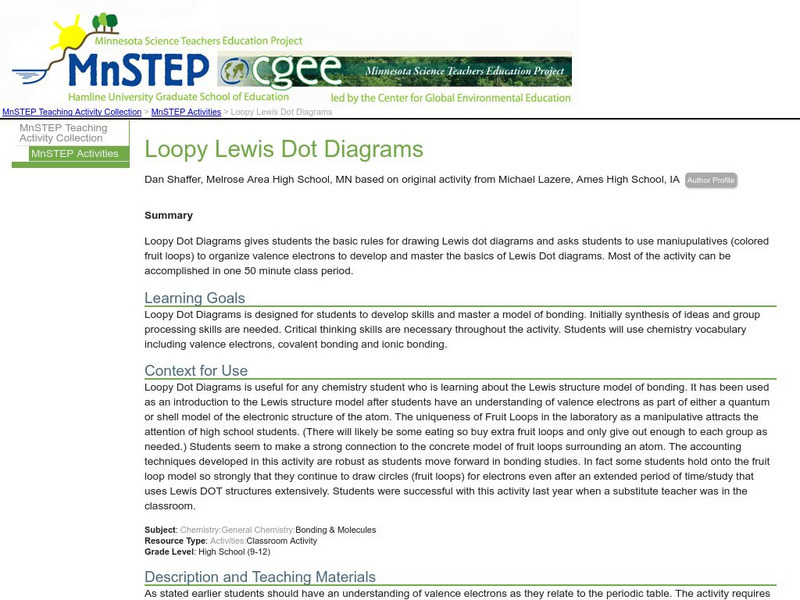LABScI
Atomic Structure and the Periodic Table of Elements: The Secret Agent Lab
Food always gets attention! Model atomic structure using fruit loops to represent the subatomic particles. After building models, scholars create ionic bonds using their models. Finally, they use these concepts to create a periodic...
Curated OER
Barf Bag Microbiology
Students investigate and determine which types of carbohydrates Baker's yeast prefers. They crumble Cheerios, Smarties, and Fruit Loops and feed them to the yeast and watch what happens, when the bags begin to barf.
UAF Geophysical Institute
System Interactions: The Lorax and the Truffula Tree
If the Lorax were to write a letter, what would he write? Introduce your class to systems and feedback loops through the whimsical stylings of Dr. Seuss. Learners take on the Lorax's point of view to write a letter, among other activities.
Curated OER
Transcription, Translation, and the Genetics of Microbes
Learners construct various virus models using Fruit loops and Alphabits to represent nucleotides and molecules. They constructs capsomeres using shoes as the capsomeres and discuss various viruses.
Curated OER
Challenges of Sampling
In this sampling learning exercise, students try different sampling methods to determine which is the best for determining contamination on a substance. This learning exercise has 5 short answer questions.
Curated OER
Life Cycles
Third graders investigate the stages of animal life cycles. They examine an egg and compare it to an inanimate object, read a booklet about the life cycle and define key vocabulary terms, and observe a mealworm. Students then design a...
Curated OER
Eat and Run
Students 'browse' like a deer, demonstrate how deer react when danger appears, demonstrate survival of the fittest, identify 4-5 sources of danger to deer and describe 1-2 ways deer protect themselves.
Curated OER
Slash Trash! Reducing, Reusing and Recycling Our Way to Zero Waste
The other "Three Rs" are covered in this lesson plan: reduce, reuse, and recycle. Over four weeks, conservationists collect data about waste in their own homes. They combine their findings with those of other students in order to analyze...
Curated OER
Recycling
Students explore the recycling process. In this recycling activity, students gain understanding of how garbage is disposed of. Students makes lists of things that can be recycled. Students discuss how animals and plants are damaged by...
Curated OER
Eat And Run
Students experience the dilemma deer face when they must browse for many hours daily yet also be on the alert for danger. They browse like deer, and demonstrate how deer react when danger appears.
Curated OER
Floating
First graders discuss with the teacher if everything will float in water. They observe a marble and determine whether it will float making predictions as a class. After observing the results, they discover that liquids exert an upward...
Curated OER
Science: Conditions for Slime Mold Survival
Students perform experiments to determine the nutritional needs and physical space requirements for slime mold to survive. After formulating hypotheses, they seal the petri dishes and set up the experiment along with two controls. ...
Curated OER
Taking Care of Nature (Religious)
Young scholars discover how they can help care for the earth. In this environmental protection lesson, students discuss how God created the earth and what will happen if they fail to care for the earth properly. Young scholars grow...
Curated OER
The Letter Qq
Learners complete a variety of activities to examine the uses for the letter Q. In this letter theme lesson, students complete arts and crafts, language arts, math, physical education, music, science, home economics, social studies, and...
Science Education Resource Center at Carleton College
Serc: Loopy Lewis Dot Diagrams
Students will use colored fruit loops to organize valence electrons to develop and master the basics of Lewis Dot diagrams. They will develop processing and critical thinking skills and also master a model of bonding.
Other popular searches
- Fruit Loops Math
- Fruit Loops Graph
- Counting Fruit Loops
- Fruit Loops Probability
- Cheerios Fruit Loops Crafts
- Graph 100 Fruit Loops
- Fruit Loops Graphing Lesson
- Fruit Loops With Fractions
- Fruit Loops Graphing
- Fruit Loops Graphing Lessson
- Fruit Loops Lesson
- Fruit Loops Probabiltity














